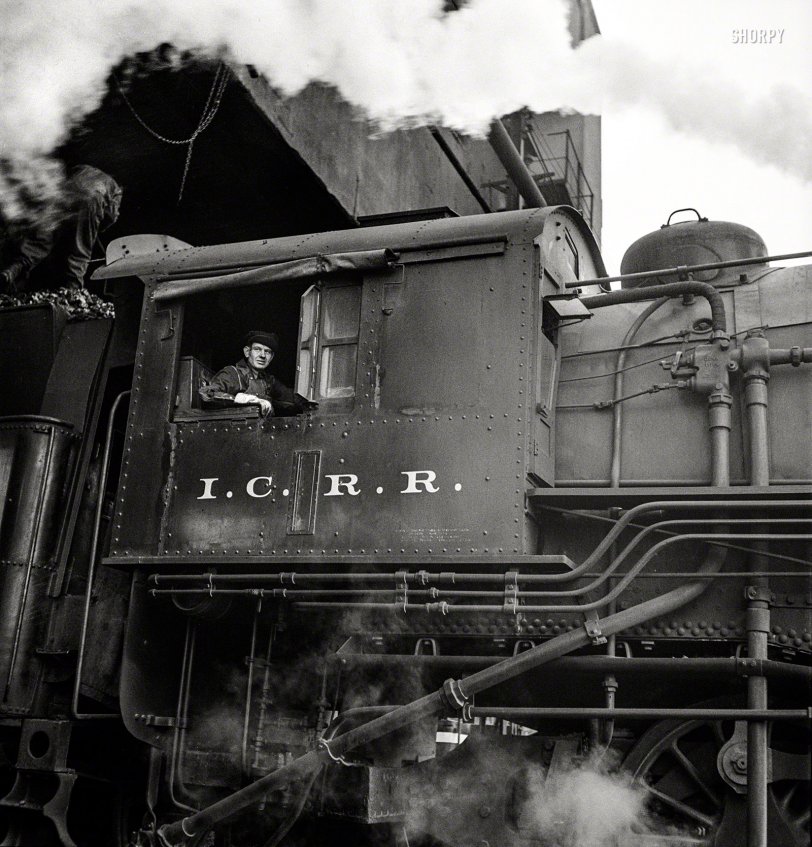


Framed or unframed, desk size to sofa size, printed by us in Arizona and Alabama since 2007. Explore now.
Shorpy is funded by you. Patreon contributors get an ad-free experience.
Learn more.

- Baldwin 62303
- Baldwin VO-1000
- Cold
- No expense spared
- Tough Guys
- Lost in Toyland
- And without gloves
- If I were a blindfolded time traveler
- Smoke Consumer Also Cooks
- Oh that stove!
- Possibly still there?
- What?!?
- $100 Reward
- Freeze Frame
- Texas Flyer wanted
- Just a Year Too Soon
- WWII -- Replacing men with women at the railroad crossing.
- Yes, Icing
- You kids drive me nuts!
- NOT An Easy Job
- I wonder
- Just add window boxes
- Icing Platform?
- Indiana Harbor Belt abides
- Freezing haze
- Corrections (for those who care)
- C&NW at Nelson
- Fallen Flags
- A dangerous job made worse
- Water Stop
Print Emporium
Illinois Central: 1942

November 1942. "Chicago, Illinois. Engine taking on coal at an Illinois Central Railroad yard." Medium-format negative by Jack Delano. View full size.
Recently rebuilt 3600 class 2-10-0 locomotive
The IC constructed 15 2-10-0 locomotives which were numbered from 3610 to 3624 over a period from 1939 to 1941. These were big engines that were pieced together from salvaged 2-8-2 and 2-10-2 locomotives. The lack of a trailing truck under the cab makes this an engine unsuited for much switching work as the trailing truck helps guide the drivers thru curves and switches.
Parts
This is apparently a switching locomotive, as indicated by the sandbox (sometimes called a dome) atop the boiler in front of the cab, with it's sand delivery pipe running down the side of the firebox to deliver dry sand to the top of the rail behind the rear driving wheels for additional traction when starting to move a heavy cut of cars.
Illinois Central locomotives, such as this one, had very commodious cabs.
Small windows in the front wall of the cab, directly behind the sandbox, are to allow the engineer, and fireman, to see the color of the smoke as it is expelled out the stack - information important to maintaining the proper, efficient operation of the locomotive.
The three parallel pipes running out of the picture to the right, from below the engineers position in the cab, are air brake control lines.
The "broken grate" firebox (the bottom of which is indicated by the double row of rivets just below the air brake lines) is above the driving wheels, indicating that this engine was designed about two decades before this portrait.
The gadget on the side of the boiler, directly below the sandbox is the injector. A simple, inexpensive, reliable, and miraculous device under the control of the engineer, that has been applied to every steam locomotive since the Civil War. With no moving parts, it takes steam from the boiler (the pipe connection at the top), sucks water from the tender (the connection below, that runs diagonally below the cab), and forces that water forward (the pipe to the right) into the boiler!
This locomotive also has been equipped with a canvas awning above the engineers window (now, rolled up). This enables the engineer to stick his head out and look back, during inclement weather, to see signals during switching movements.
























On Shorpy:
Today’s Top 5